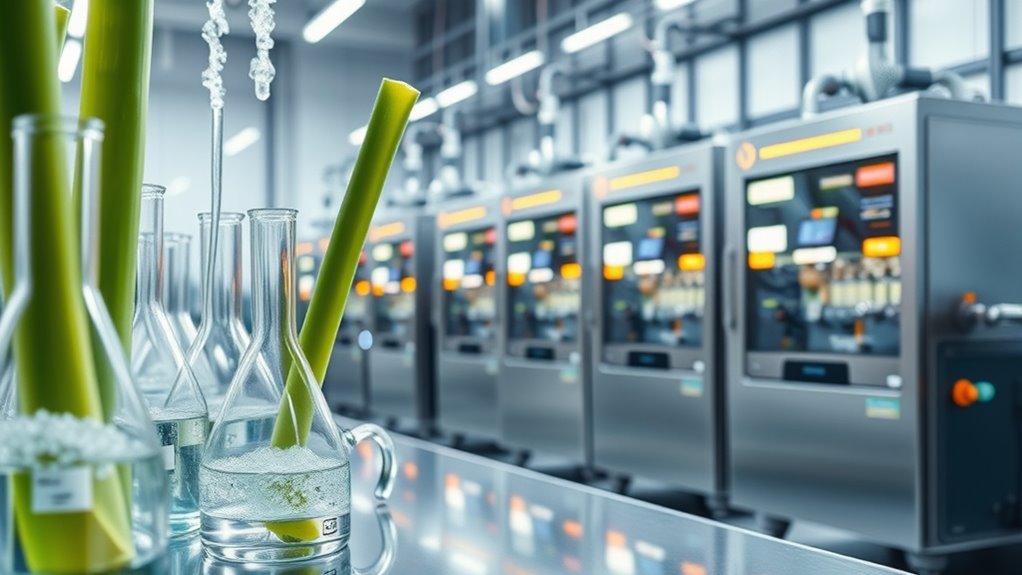The future of decaf coffee is focused on eco-friendly and flavor-preserving methods like supercritical CO₂, sugarcane-based extraction, and advanced solvent techniques. CO₂ extraction offers a natural, chemical-free process that retains beans’ freshness, while sugarcane uses sustainable ingredients for a greener approach. Solvent methods are evolving to become safer and more efficient. If you’re curious about how these innovations will shape your favorite decafs, there’s more to explore below.
Key Takeaways
- CO2 extraction is becoming the preferred eco-friendly method due to its safety and flavor preservation benefits.
- Sugarcane-based decaffeination offers a natural, sustainable alternative aligning with organic and eco-conscious consumer trends.
- Innovations focus on balancing high caffeine removal efficiency with minimal flavor loss and environmental impact.
- Future decaf processes aim to reduce reliance on chemical solvents, enhancing safety and sustainability.
- Integration of environmentally friendly techniques will drive the evolution of decaffeination toward more natural, efficient methods.

Have you ever wondered how decaf coffee is made? It’s a fascinating process that involves several decaffeination methods, each designed to remove caffeine while preserving the coffee’s rich flavors. One common approach is chemical extraction, where a solvent interacts with the coffee beans to extract caffeine. This method is widely used because it’s efficient and effective at removing caffeine without stripping away the essential oils and flavors that make coffee enjoyable. During chemical extraction, a solvent such as methylene chloride or ethyl acetate is applied to the beans. The beans are either soaked or steamed to open their pores, allowing the solvent to penetrate more deeply. The solvent then bonds with the caffeine molecules, drawing them out of the beans. Once caffeine is extracted, the beans are thoroughly rinsed to remove any residual solvent, ensuring the final product is safe for consumption. This process is carefully controlled to maintain the integrity of the beans’ flavor profile, which is *vital* for quality decaf coffee.
While chemical extraction has been a standard method for decades, new innovations are shaping the future of decaffeination. One such method is using supercritical carbon dioxide (CO2). In this process, CO2 is pressurized until it becomes a supercritical fluid—neither a liquid nor a gas but possessing properties of both. When the beans are exposed to supercritical CO2, it acts like a solvent that selectively bonds with caffeine molecules. This method is considered more environmentally friendly because it avoids the use of potentially harmful chemicals and can be reused multiple times. Plus, it preserves more of the beans’ original flavor, resulting in a cleaner, more natural-tasting decaf coffee. The CO2 is then depressurized, releasing the caffeine, which is captured and removed, leaving behind the flavorful, decaffeinated beans.
Another promising development involves using sugarcane-based processes. This method leverages the natural sugars and compounds found in sugarcane to extract caffeine, offering a more natural alternative to chemical solvents. The sugarcane process often involves creating a solution that selectively dissolves caffeine without impacting other flavor compounds. It’s an eco-friendly approach that appeals to consumers seeking organic and sustainable options. As research continues, these innovative methods could become more prevalent, reducing reliance on chemical solvents and making decaf coffee even better for both consumers and the planet. Overall, the future of decaf coffee involves balancing efficiency, flavor preservation, and environmental responsibility, with advancements like CO2 extraction and sugarcane processes leading the way.
Frequently Asked Questions
How Does Decaf Coffee Retain Its Flavor After Decaffeination?
Decaf coffee retains its flavor through effective flavor preservation during decaffeination. Advanced techniques like CO2 and water processes gently extract caffeine while keeping the beans’ natural oils and aromatics intact. You’ll notice that quality decaf preserves much of the original flavor profile, thanks to these careful decaffeination techniques. By selecting beans processed with these methods, you guarantee a richer, fuller taste experience without the caffeine kick.
Are There Health Differences Between Decaf and Regular Coffee?
Imagine stepping into a morning routine, wondering if decaf or regular coffee impacts your health. You might have health concerns or caffeine sensitivity, but decaf generally contains fewer caffeine-related issues. While it still offers antioxidants, decaf reduces caffeine intake, easing anxiety or sleep troubles. Both options are safe for most people, but if caffeine affects you, decaf is a gentle alternative that helps you enjoy coffee without the jitters.
What Environmental Impacts Are Associated With Decaffeination Methods?
You should consider that decaffeination methods influence the environmental footprint and potential chemical residues. Solvent processes can leave chemical traces and use more resources, impacting the environment. CO2 and sugarcane methods tend to have a smaller footprint, using fewer chemicals and less energy. By choosing decaf produced with eco-friendlier techniques, you reduce chemical residues and support more sustainable practices in coffee production.
Can Decaf Coffee Be Fully Caffeine-Free With Current Processes?
Yes, with current decaffeination efficacy, you can enjoy coffee that’s nearly caffeine-free, but it’s tough to achieve complete removal. Bean-specific processes, like supercritical CO2 or solvent methods, reduce caffeine content markedly, often to less than 2-3 mg per cup. However, trace amounts may remain, so while it’s very close to caffeine-free, absolute elimination isn’t guaranteed. Your best bet is choosing decaf processed with advanced, bean-specific techniques for minimal caffeine.
How Do Decaf Coffee Processes Vary Across Different Coffee Bean Types?
Ever wonder how decaf coffee varies across bean types? Well, different decaf bean varieties respond uniquely to processing method variations. Arabica beans often retain more flavor with gentle methods like CO2 or sugarcane, while Robusta might need stronger decaffeination techniques. These differences influence caffeine removal efficiency and taste. So, you’ll notice that the processing method adapts to each bean’s unique characteristics to deliver a satisfying decaf experience.
Conclusion
No matter which decaf process you choose—solvent, CO2, or sugarcane—you’re stepping into a future where your coffee experience is as rich and vibrant as a sunrise. These methods are revolutionizing decaf, making it more flavorful and sustainable than ever before. So, next time you sip that cup, remember you’re savoring a brew that’s transformed by innovation—truly a marvel in every drop, brighter than a thousand suns.










